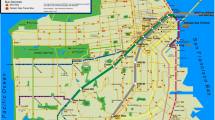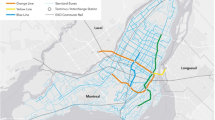Abstract
Transportation network companies (TNC) provide mobility services that are influencing travel behavior in unknown ways due to limited TNC trip-level data. How they interact with other modes of transportation can have direct societal impacts, prompting appropriate policy intervention. This paper outlines a method to inform such policies through a data-driven approach that specifically analyzes the interaction between TNCs and bus services in Pittsburgh, PA. Uber surge multiplier data is used over a 6-month time period to approximate TNC usage (i.e., demand over supply ratio) for ten predefined points of interest throughout the city. Bus boarding data near each point of interest is used to relate TNC usage. Data from multiple sources (weather, traffic speed data, bus levels of service) are used to control for conditions that influence bus ridership. We find significant changes in bus boardings during periods of unusually high TNC usage at four locations during the evening hours. The remaining six locations observe no significant change in bus boardings. We find that the presence of a dedicated bus way transit station or a nearby university (or dense commercial zones in general) both influence ad-hoc substitutional behavior between TNCs and public transit. We also find that this behavior varies by location and time of day. This finding is significant and important for targeted policies that improve transportation network efficiency.










Similar content being viewed by others
Notes
UberHOP is a fixed-route, flat-rate form of micro-transit that was piloted in Seattle, WA during 2015.
Small MSAs include all MSAs with populations less than the median MSA population while large MSAs have populations greater than the median MSA population.
Transit scores were obtained from AllTransit. AllTransit provides transit scores at a city level for all different modes of transit.
The minimum surge multiplier for Uber services is 1.2, which means that the rider fare is multiplied by 1.2, making the fare 20% greater. The minimum surge for Lyft is 25%, meaning that an additional 25% of the fare is charged to the rider.
U.S. Census Bureau, 2015 American Community Survey.
Data is not collected for every time period due to limited probe vehicles.
The thresholds were chosen to match surge multiplier levels used by Uber at the time of the study.
References
Babar, Y., Burtch, G.: Examining the impact of ridehailing services on public transit use. SSRN (2017)
Boisjoly, G., Grise, E., Maguire, M., Veillette, M.-P., Deboosere, R., Berrebi, E., El-Geneidy, A.: Invest in the ride: a 14 year longitudinal analysis of the determinants of public transport ridership in 25 North American cities. Transp. Res. Part A 116, 434–445 (2018)
Brown, A.: Ridehail revolution: ridehail Travel and equity in Los Angeles. Ph.D. thesis (2018)
Clewlow, R., Mishra, G.: Shared mobility: current adoption, use, and potential impacts on travel behavior. Transp. Res. Rec. (2017)
Cohon, P., Hahn, R., Hall, J., Levitt, S., Metcalfe, R.: Using big data to estimate consumer surplus: the case of Uber. Technical report, National Bureau of Economic Research (2016)
Conway, M., Salon, D., King, D.: Trends in taxi use and the advent of ridehailing, 1995–2017: evidence from the US National Household Travel Survey. Urban Sci. 2(3), 79 (2018)
Cookson, G.: INRIX global traffic scorecard (2017)
Daniels, M.: Survey: many Pittsburgh commuters use vehicle, light rail and bus. https://archive.triblive.com/local/pittsburgh-allegheny/survey-many-pittsburgh-commuters-use-vehicle-light-rail-and-bus/ (2016). Accessed 6 Jan 2020
Erhardt, G., Roy, S., Cooper, D., Sana, B., Chen, M., Castiglione, J.: Do transportation network companies decrease or increase congestion? Sci. Adv. 5, eaau2670 (2019)
Feigon, S., Murphy, C.: Broadening understanding of the interplay between public transit, shared mobility, and personal automobiles. Technical Report, Shared-Use Mobility Center. https://capitolhillvillage.org/wp-content/uploads/2018/11/Mobility-and-More.pdf (2018). Accessed 5 Feb 2020
Gehrke, S., Felix, A., Reardon, T.: Fare choices: a survey of ride-hailing passengers in metro Boston. Technical report. Metropolitan area planning council. http://www.mapc.org/wp-content/uploads/2018/02/Fare-Choices-MAPC.pdf (2018). Accessed 5 Feb 2020
Graehler, M., Mucci, R., Erhardt, G.: Understanding the recent transit ridership decline in major US cities: service cuts or emerging modes?. In: 98th Annual Meeting of the Transportation Research Board (2017)
Grahn, R., Harper, C.D., Hendrickson, C., Matthews, H.S., Qian, Z.S.: Socioeconomic and usage characteristics of transportation network company riders. Transportation (2019). https://doi.org/10.1007/s11116-019-09989-3
Hall, J.D., Price, J., Palsson, C.: Is Uber a substitute or complement to public transit? J. Urban Econ. 108, 36–50 (2018)
Hampshire, R., Simek, C., Fabusuyi, T., Di, X., Chen, X.: Measuring the impact of an unanticipated disruption of Uber/Lyft in Austin, TX. SSRN (2017)
Henao, A.: Impacts of ridesourcing - Lyft and Uber—On transportation including VMT, mode replacement, parking, and travel behavior. Ph.D. thesis (2017)
Henao, A., Marshall, W.E.: The impact of ride-hailing on vehicle miles traveled. Transportation 46(6), 2173–2194 (2018)
Hoffmann, K., Ipeirotis, P.G., Sundararajan, A.: Ridesharing and the use of public transportation. In: International Conference on Information Systems (2016)
Jin, S., Kong, H., Sui, D.: Uber, public transit, and urban transportation equity: a case study in New York City. Prof. Geogr. 71, 315–330 (2019)
Johana, B.: Uber powered four billion rides in 2017. It wants to do more—and cheaper—in 2018. https://www.recode.net/2018/1/5/16854714/uber-four-billion-rides-coo-barney-harford-2018-cut-costs-customer-service. Accessed 11 December 2018 (2018)
Kerr, D.: Lyft grows gangbusters in 2017, bringing competition to Uber. https://www.cnet.com/news/lyft-sees-massive-growth-brings-uber-competition/. Accessed 11 December 2018 (2018)
Lavieri, P.S., Dias, F.F., Juri, N.R., Kuhr, J., Bhat, C.R.: A model of ridesourcing demand generation and distribution. Transp. Res. Rec. 2672(46), 31–40 (2018)
Lewis, E., MacKenzie, D.: UberHOP in Seattle: who, why, and how? Transp. Res. Rec. 2650(1), 101–111 (2017)
Mallett, W.: Trends in public transpsortation ridership: implications for federal policy (2018)
Mucci, R.: Transportation network companies: influencers of transit ridership trends. Ph.D. thesis (2017)
Murphy, S.F., Colin: shared mobility and the transformation of public transit. Technical report, Shared-Use Mobility Center. https://www.apta.com/wp-content/uploads/Resources/resources/reportsandpublications/Documents/APTA-Shared-Mobility.pdf (2016). Accessed 5 Feb 2020
Nelson, E., Sadowsky, N.: Estimating the impact of ride-hailing app company entry on pubilc transportation use in major US urban areas. BE J. Econ. Anal. Policy 19(1), 1–21 (2019)
Pi, X., Egge, M., Whitmore, J., Qian, Z.S., Silbermann, A.: Understanding transit system performance using AVL-APC data: an analytics platform with case studies for the Pittsburgh region. J. Public Transp. 21(2), 2 (2018)
Public Transportation Fact Book (2019)
Rayle, L., Dai, D., Chan, N., Cervero, R., Shaheen, S.: Just a better taxi? A survey-based comparison of taxis, transit, and ridesourcing services in San Francisco. Transp. Policy 45, 168–178 (2016)
Schaller, B.: IN a reversal, ’Car-Rich’ households are growing. https://www.citylab.com/perspective/2019/01/uber-lyft-make-traffic-worse-more-people-own-cars-transit/579481/ (2019). Accessed 5 Feb 2020
Sperling, D.: Three revolutions; steering automated, shared, and electric vehicles to a better future. Island Press (2018)
Steinmetz, K.: Lyft and Uber are ’Allies’ in the transit revolution. http://time.com/4259615/lyft-uber-apta-mobility-study/. Accessed 25 Match 2019 (2016)
Acknowledgements
This research is funded in part by National Science Foundation Award CMMI-1751448 and Carnegie Mellon University’s Mobility21, a National University Transportation Center for Mobility sponsored by the US Department of Transportation. The contents of this report reflect the views of the authors, who are responsible for the facts and the accuracy of the information presented herein. The U.S. Government assumes no liability for the contents or use thereof. We would also like to thank the anonymous reviewers for their valuable suggestions.
Author information
Authors and Affiliations
Contributions
RG: literature review, study conception and design, data analytics, analysis and interpretation of results, manuscript preparation. SQ: study conception and design, data acquisition, analysis and interpretation of results, manuscript preparation. HSM interpretation of results, manuscript preparation. CH interpretation of results, manuscript preparation
Corresponding author
Ethics declarations
Conflict of interest
On behalf of all authors, the corresponding author states that there is no conflict of interest.
Additional information
Publisher's Note
Springer Nature remains neutral with regard to jurisdictional claims in published maps and institutional affiliations.
Rights and permissions
About this article
Cite this article
Grahn, R., Qian, S., Matthews, H.S. et al. Are travelers substituting between transportation network companies (TNC) and public buses? A case study in Pittsburgh. Transportation 48, 977–1005 (2021). https://doi.org/10.1007/s11116-020-10081-4
Published:
Issue Date:
DOI: https://doi.org/10.1007/s11116-020-10081-4




